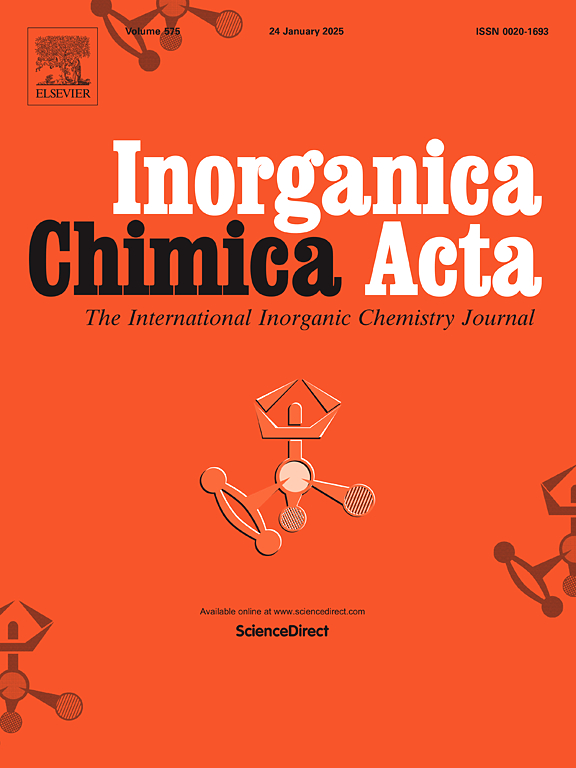Synthesis, crystal structures and anticancer studies of Ni (Ⅱ) and Co (III) complexes based on 2-(2-aminophenyl)-1H-benzimidazole Schiff base derivatives
IF 2.7
3区 化学
Q2 CHEMISTRY, INORGANIC & NUCLEAR
引用次数: 0
Abstract
Two new ligands, 2-(5,6-dihydrobenzo[4,5]imidazo[1,2-c]quinazolin-6-yl)phenol (H2L1′) and 2-(5,6-dihydrobenzo[4,5]imidazo[1,2-c]quinazolin-6-yl)-4-fluorophenol (H2L2′) were synthesized by 2-(2-aminophenyl)benzimidazole with salicylaldehyde and 5-fluorosalicylaldehyde, respectively. While the two ligands (H2L1′ and H2L2′) were coordinated with nickel (II) and cobalt (II) ions and represented open-chain Schiff base structures (H2L1 and H2L2). Their metal complexes: [Ni2 (HL1)2 (C2H5OH)2 Cl2]‧2C2H5OH (complex 1), [Co (HL1) (L1)] (complex 2), [Ni2 (HL2)2 (C2H5OH)2 Cl2]‧2C2H5OH (complex 3) and [Co (HL2) (L2)] (complex 4) were obtained by solvothermal reaction. The four Schiff base complexes were characterized by infrared spectroscopy, elemental analysis, thermal stability analysis, X-ray powder diffraction, single-crystal X-ray diffraction, and lipophilicity assay. Single crystal X-ray analysis reveals that complexes 1 and 3 crystallize in a monoclinic system with space group P21/n, while complexes 2 and 4 crystallize in a trigonal system with space group R-3. The lipophilicity assay (Log P) showed that the introduction of fluorine atoms enhanced the lipophilicity of ligands and complexes. The MTT method was used to determine the IC50 values of complexes, ligands, and cisplatin against four different tumor cells (A-549, SMMC-7721, MDA-MB-231, and CNE-2Z) and one normal cell (IOSE 80). The results indicated that the four complexes exhibited stronger anticancer efficacy than ligands, among which the fluorine-substituted Co (III) complex (complex 4) displayed greater cytotoxicity compared with cisplatin in inhibiting SMMC-7721, MDA-MB-231 cells and A-549 cells, respectively. In addition, complex 4 can increase intracellular reactive oxygen species levels, arrest cells in the G0/G1 phase, upregulate Bax levels, and downregulate Bcl-2 levels, inducing MDA-MB-231 cell apoptosis in a dose-dependent manner.

求助全文
约1分钟内获得全文
求助全文
来源期刊

Inorganica Chimica Acta
化学-无机化学与核化学
CiteScore
6.00
自引率
3.60%
发文量
440
审稿时长
35 days
期刊介绍:
Inorganica Chimica Acta is an established international forum for all aspects of advanced Inorganic Chemistry. Original papers of high scientific level and interest are published in the form of Articles and Reviews.
Topics covered include:
• chemistry of the main group elements and the d- and f-block metals, including the synthesis, characterization and reactivity of coordination, organometallic, biomimetic, supramolecular coordination compounds, including associated computational studies;
• synthesis, physico-chemical properties, applications of molecule-based nano-scaled clusters and nanomaterials designed using the principles of coordination chemistry, as well as coordination polymers (CPs), metal-organic frameworks (MOFs), metal-organic polyhedra (MPOs);
• reaction mechanisms and physico-chemical investigations computational studies of metalloenzymes and their models;
• applications of inorganic compounds, metallodrugs and molecule-based materials.
Papers composed primarily of structural reports will typically not be considered for publication.
 求助内容:
求助内容: 应助结果提醒方式:
应助结果提醒方式:


